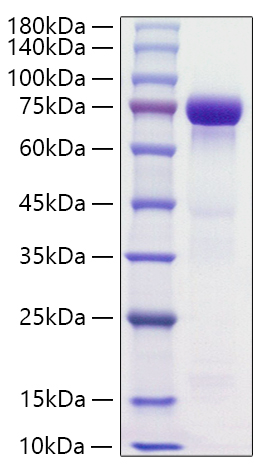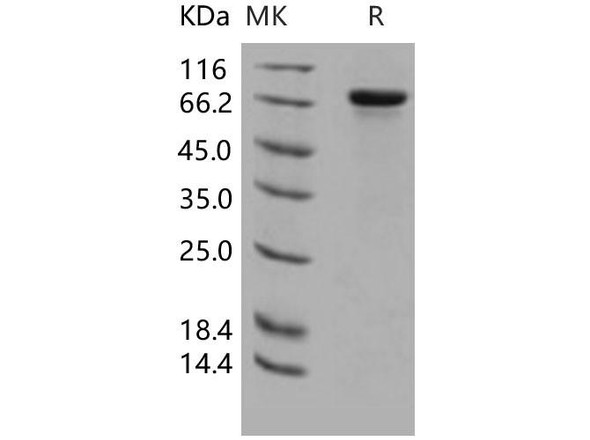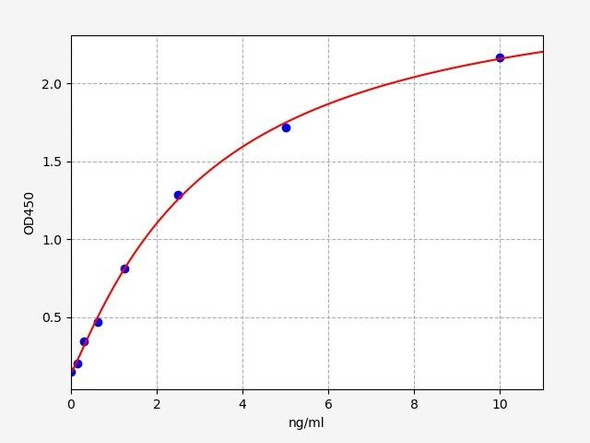Description
Recombinant Human HRG/HPRG Protein
The Recombinant Human HRG/HPRG Protein is a biologically active recombinant protein that plays a significant role in various cellular processes and signaling pathways in human biology. This protein is widely employed in immunological research, cell biology studies, protein-protein interaction analyses, and therapeutic development, providing researchers with a reliable tool for investigating HRG/HPRG function and its implications in health and disease.
This product (SKU: RPCB1188) is produced using HEK293 cells and features a C-His tag for convenient detection and purification. The protein exhibits a calculated molecular weight of 58.50 kDa with an observed molecular weight of 75 kDa under denaturing conditions, achieving ≥ 95 % as determined by SDS-PAGE.. Functional bioactivity has been validated through rigorous quality control assays, confirming its suitability for demanding research applications.
Key Features
| High Purity by Affinity Chromatography | |
| Mammalian & Bacterial Expression Systems | |
| High lot-to-lot consistency via strict QC |
| Product Name: | Recombinant Human HRG/HPRG Protein |
| SKU: | RPCB1188 |
| Size: | 10 μg , 20 μg , 50 μg , 100 μg |
| Reactivity: | Human |
| Synonyms: | HPRG, HRGP, THPH11, HRG |
| Tag: | C-His |
| Expression Host: | HEK293 cells |
| Calculated MW: | 58.50 kDa |
| Observed MW: | 75 kDa |
| Gene ID: | 3273 |
| Protein Description: | High quality, high purity and low endotoxin recombinant Recombinant Human HRG/HPRG Protein (RPCB1188), tested reactivity in HEK293 cells and has been validated in SDS-PAGE.100% guaranteed. |
| Endotoxin: | < 0.1 EU/μg of the protein by LAL method. |
| Purity: | ≥ 95 % as determined by SDS-PAGE. |
| Formulation: | Lyophilized from a 0.22 μm filtered solution of PBS, pH 7.4. |
| Bio-Activity: | Measured by its ability to support the adhesion of MOLT-4 human acute lymphoblastic leukemia cells. Human HPRG immobilized at 1 μg/ml (100 μl/well) will induce >73.04% MOLT4 cell adhesion (1 x 10E5 cells/well) in the presence of 7.5 μg/ml Concanvalin A. |
| Reconstitution: | Centrifuge the vial before opening. Reconstitute to a concentration of 0.1-0.5 mg/mL in sterile distilled water. Avoid vortex or vigorously pipetting the protein. For long term storage, it is recommended to add a carrier protein or stablizer (e.g. 0.1% BSA, 5% HSA, 10% FBS or 5% Trehalose), and aliquot the reconstituted protein solution to minimize free-thaw cycles. |
| Storage: | Store at -20℃.Store the lyophilized protein at -20℃ to -80 ℃ up to 1 year from the date of receipt. After reconstitution, the protein solution is stable at -20℃ for 3 months, at 2-8℃ for up to 1 week. |
Histidine-rich glycoprotein, also known as HRG and HPRG, is a glycoprotein located in plasma and platelets and contains an unusually large amount of histidine and proline.The specific functions of HRG remain unclear, but it is known that the protein binds heme, dyes, and divalent metal ions. It inhibits rosette formation and interacts with heparin, thrombospondin, and plasminogen. Two of the protein's effects, the inhibition of fibrinolysis, and the reduction of inhibition of coagulation indicate a potential prothrombotic effect. HPRG is evolutionarily, functionally, and structurally related to cleaved high molecular weight kininogen (HKa), an anti-angiogenic polypeptide that stimulates apoptosis of proliferating endothelial cells through binding to cell-surface tropomyosin. The antiangiogenic activity of the multidomain plasma protein HPRG is localized to its histidine-proline-rich (H/P) domain and has recently been shown to be mediated, at least partially, through binding to cell-surface tropomyosin in fibroblast growth factor-2-activated endothelial cells.







